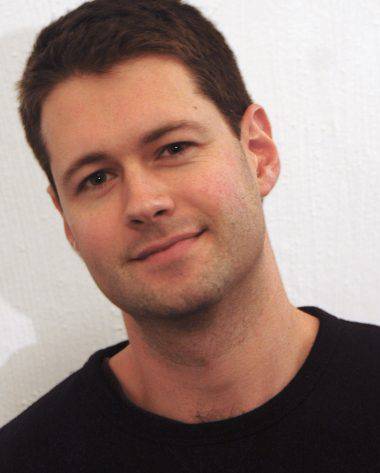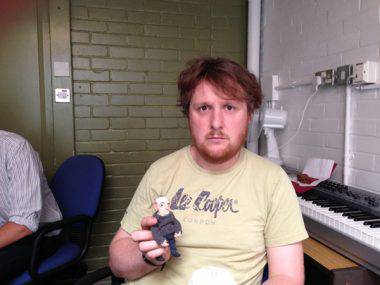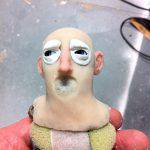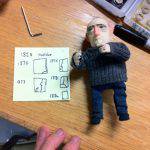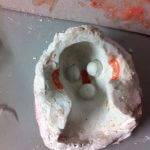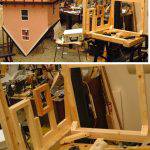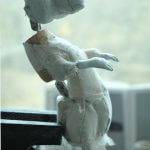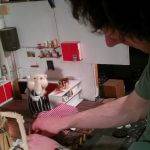WATCH: Two Films About Loneliness Released Online
Two Films About Loneliness is the joint directorial short by Royal College of Art graduates Chris Eales and Will Bishop Stephens. This unique film about noisy neighbours, online love, cooking and giant German hamsters is not only a quirky film for its split screen delivery, bilingual script and dual stop motion approaches, but is a showcase in collaboration as the two directors work together on a single vision that also manages to show off their own stop motion styles with little compromise to the benefit of the film. The film has had a fantastic festival run, screening at Sundance, Anim’est, Encounters, Edinburgh, Montreal Stop Motion Film Festival and many others. The film is now online to view in its entirity.
If there is an art to collaboration then these two directors have presented an approach that has rarely been demonstrated to this level. Skwigly caught up with directors Chris Eales and Will Bishop Stephens to find out more about the film.
Together you conjured up the idea to collaborate, who came up with what elements of the plot?
Will Bishop Stephens: We had a tiny shared space for about a year, just after we both graduated. We knew we couldn’t make two stop-motion films in the same space, so we thought about filming them back to back, with the foreground of one becoming the background of the other one. We never got time to use that studio space for much at all in the end, but it set us thinking in a different way, where it was more about problem solving than an individuals vision.
Chris Eales: The limitations in this space made us think that this could be worked into the film – two films are being made side by side but keep interfering with each other. When we eventually moved into separate studio spaces we continued to meet and rewrite the story, using threads of string to determine how the two worlds interfered with one another.
Will: It was string pinned between drawings, like something from a police drama.
Chris: …Maybe we should have made it a police drama
Chris Eales
Will: The structure went through a few rewritings, with pauses in between where it was dormant for a few months or a couple of years. In the initial idea we needed two very different films to make them conflict, so first off I went away and made a storyboard for a character who was trying to making a highly symbolic art piece about being alone, something like a cod Bergman film, and Chris’s character would have been making a Cookery show for TV.
It changed a lot as we worked out the problems of having a film within a film, like ‘who is filming it?’ In the end they are both making videos for the internet, where they are broadcasting out into the world but they are alone and maybe no-one is listening.
How did you find collaboration when you were working so far apart? Who managed schedules etc?
Chris: We continued to work remotely using drop box to share footage. Will wrote the side of his character and I wrote mine, based largely on clips from cooking shows, it was like making a collage. We would meet every now and then to compare notes and tweak the story if we needed to.
Will: Chris finished earlier than me which helped a lot with timing the cross-overs, where sound would leak from one film into the other.
Tim Key
When the shooting was done I worked with Simon Allmark on the technical side of the edit. Simon was rebuilding from the two sets of frames we had shot into a single edit with a consistent colour grade and Joe Sudlow built the sound- Me and Joe and Simon had technician jobs at UCA Farnham at that time. We used any down time we had that year on Two Films About Loneliness. They both did a lot towards making it feel like a real film.
We fundraised for money to have Tim Key be the voice of Jonathan Smallman, and he came to Farnham to record in the sound studio there, and then we had to re-sync the voice to the image afterwards. I think we applied to Oberhausen Film Festival while it was still being rebuilt. We had to work out how to make a DCP
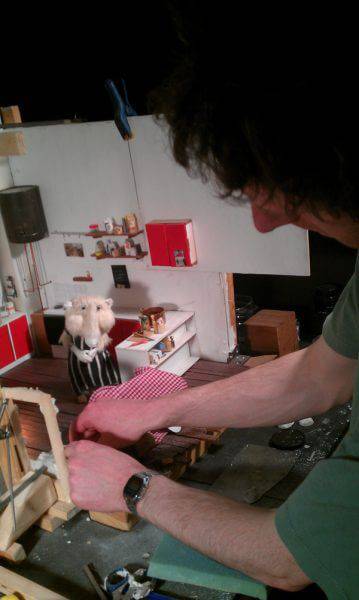
Would you work in this format again, are there other stories you can tell from this viewpoint?
Chris: Since touring with the film we have started to play with a similar format for a second film but it is early days.
Will: We’ve had a chance to talk about ideas when we’ve been at festivals with the film, which has been nice. We had an idea for splitting the frames between us or layering the image but there is something more direct about splitting the screen space. We’ve since talked about just splitting the screen lengthways and seeing what problems that throws up.
I’ve had a baby since then, but I’m building a shed/studio in the garden so I’m hopeful about being able to make films this year.
One thing I wondered since watching the film was if the size difference written into the script before or after you knew the size of one another’s puppets? Did you surprise each other throughout or was production more regimented?
Will: The size difference gag came pretty early on, I think.
Chris: The idea to play with scale as a visual gag was lifted from another idea for a film. But I think we both liked how it seemed to fit for this project because it suited the hand-made nature of puppet animation.
Is there anything you did learn from this collaborative project that you do not think you would have if you both had direct directorial control on a solo project?
Chris: It was exciting to watch how a project can grow as more people begin to come on board. Joe Sudlow, who did our sound and foley was outstanding with help and advise and it was thrilling to have people like Ed Patrick and Tim Key get behind the film as I’m a big fan of their work.
Will: Me too!
Chris: Working together with Will meant that there was always a new idea or approach to respond to and this really helped ideas pick up momentum. We also did a lot of tests and experiments especially when we were building the puppets, and because Will has a background in sculpture I picked up lots of interesting tips from him. Working collaboratively is a great way to work. You end up with something that is more than the sum of it’s parts.
Will: Definitely. I think collaborating makes you more likely to see the project clearly too, there’s a more problem solving approach. I maybe tend to go into a bit of a trance around a project and keep in that trance until the creative process is over, not communicating with anyone and defending that first thought.
With this project we had a series of problems to solve and we looked at structures that solved that problem and the next problem until it was all there. It was less neurotic. The animating itself was as trance like as ever, because the character needs to be alive, but the pre and post production was super methodical and I learned a lot from that, being productive and finding ways to articulate your thoughts.
Chris was a very good person to work with, together we would come up with solutions to problems that other people wouldn’t see the point of.
Chris: I think we also came up with the problems!
See a gallery of images from the making of the film below. You can find out more about the film by visiting twofilmsaboutloneliness.com.


